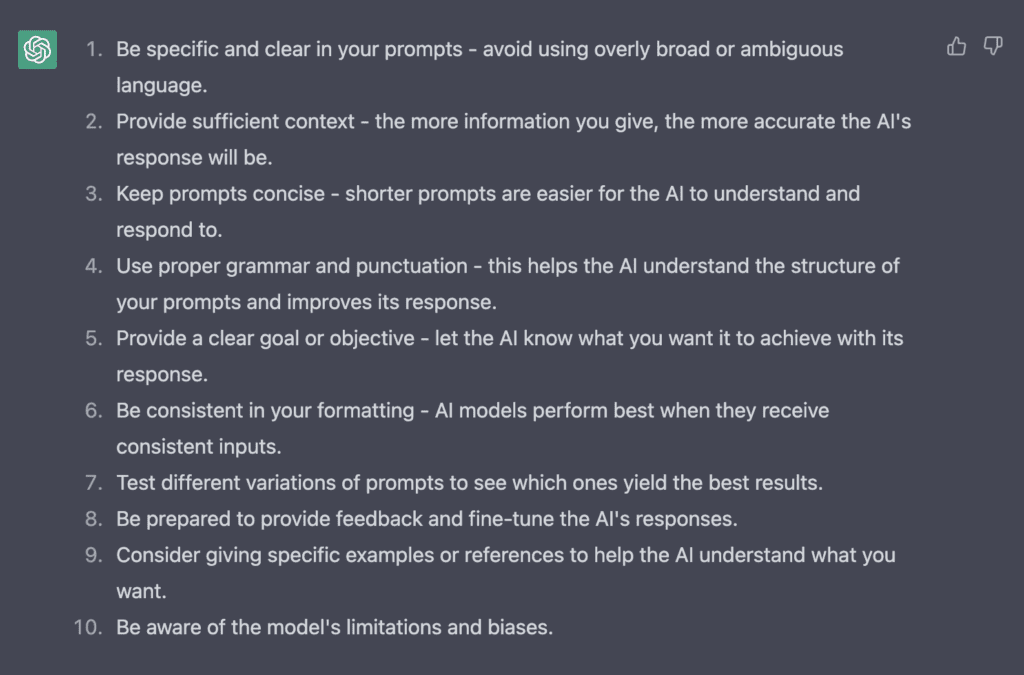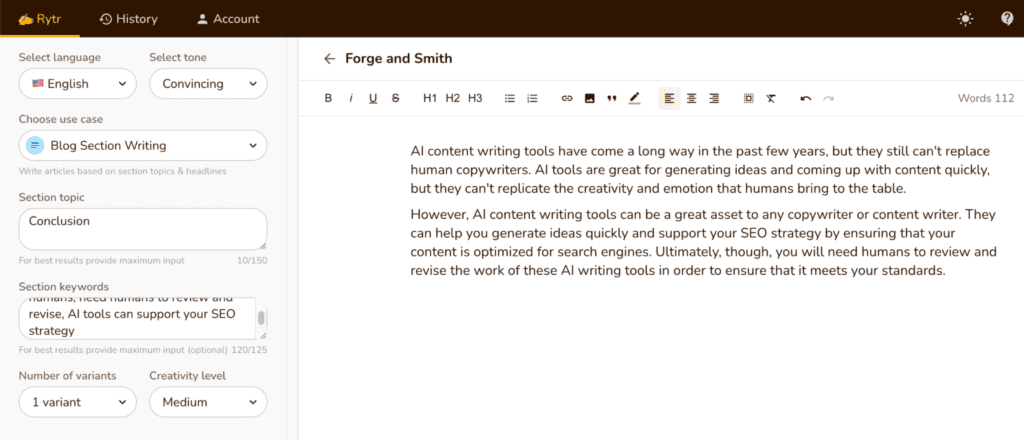AI content writing is the talk of the SEO industry right now thanks to ChatGPT, and news of its capabilities has reached business owners far and wide.
We all know that we need fresh, optimized content to help us rank for relevant searches and stay competitive. There tends to be an unfair advantage to bigger companies that employ SEO experts and writers and designers, while small businesses with a tight budget and no marketing team can struggle to produce even one piece of content each month.
So of course when you hear about a free AI tool that can write everything from blog posts to white papers you get excited – it’s like an extra employee you don’t have to pay! But there’s so much more to AI content writing than meets the eye.
Here are the key considerations:
- Content marketing should be about creating helpful content for humans
- Original content with a unique perspective tends to rank higher
- Content automatically and entirely generated by AI just for SEO purposes violates Google’s Search Essentials (formerly Webmaster Guidelines)
- It also goes against Google’s recent Helpful Content Update and E-E-A-T quality guidelines
- According to AuthorityHacker 63% of AI adopters cite inaccuracies in AI content as a major challenge – yet 75.7% of marketers do use AI tools for work
So yes, you should absolutely take advantage of AI writing tools to support your SEO strategy – we’re starting to recommend it to our clients to help create website content and blog posts. But the operative word there is “support.”
AI tools themselves are not a strategy; you need to know which jobs to give them to make the most of their capabilities, and which jobs are still best left to humans. That’s what we’re going to talk about right now! It’s a hefty topic, so hold onto your hats – and feel free to use the Table of Contents to jump around.
Post Contents
What is AI content writing?
AI content writing is the practice of using an artificial intelligence (AI) writing tool to generate online content. This might be for your website, social media, email marketing, or any other aspect of your digital strategy.
ChatGPT is the hot new AI tool on the scene, shocking the world with its ability to write all kinds of grammatically sound marketing content. But AI writing tools are not new.
Let’s take a brief look at three types of popular AI tools in marketing and their uses.
1. AI Writing Assistants
AI writing assistants have been around for a long, long time. The first official spell checker was created in Stanford University’s AI Lab in 1971. And for those of us who spent more time in the 1980s using Tandy’s “Text” writing app than playing with other children, we got to use the earliest versions of AI for personal computers.

What AI writing assistants do is take text you’ve already written and suggest ways to improve your spelling, grammar, and readability. They also suggest text to complete sentences based on machine learning (either from other humans or from your own habits).
They can also auto-correct text for you as you go, which we’ve all seen fail horribly in our messaging apps.


Here are common writing assistants you have probably already used:
- Built-in proofreading assistants in Google Docs, Microsoft Word, Pages, and basically every text document software on the market
- Built-in proofreading assistants in smartphones
- Built-in proofreading assistants on any PC or Mac
- Gmail’s suggested replies and suggested next words or phrases
- Grammarly and other popular tools that provide suggestions for grammar plus style and tone
That’s just a small sampling. AI writing assistants are everywhere! You can add a browser extension or use a WordPress plugin to proofread pretty much anything you write for your business.
2. AI Content & SEO Support Tools
These tools go beyond editing your existing text, and also provide extra benefits specific to content marketing and SEO work.
- SEMRush has an on-page SEO checker for existing content, content templates (based on your competitors), and an SEO writing assistant
- CoSchedule has a powerful headline analyzer to help improve SEO and CTR for your headline ideas
- HubSpot has tools that generate blog titles and buyer persona documentation based on your input
- Yoast SEO is a WordPress plugin that grades your content, giving you suggestions to improve the quality, readability, and optimization
- RankMath is similar to Yoast SEO, as is All in One SEO
- Copy.AI and StoryLab.AI are among the tools that write social media captions based on your input
- Chatbots can answer questions 24/7 and help you retain website leads or sales that could be lost outside business hours
3. AI Content Writing Tools
Finally, we have AI content writing tools – the ones that can write complete copy for you, as long as you ask them the right way.
Here are some of the leaders in AI writing:
- ChatGPT – the one everybody is talking about, has search engine-like capabilities and it’s free
- Jasper AI – 72% of SEO experts in a poll preferred Jasper over ChatGPT
- Rytr – this free tool has helpful drop-down options and fields that guide you to delivering an effective prompt, the drawback is the character limit in the fields
- Chibi – subscription or pay-as-you-go required
- Article Forge – obviously we love the name, but credit card required to unlock a free trial
I could go on, but this article isn’t just about the tools. You can easily find well-researched roundups of AI content writing tools, like this one from Renaissance Rachel and this comparison of AI writing tools by Search Engine Journal.
You can also learn more about free ChatGPT alternatives, for those times when ChatGPT is down or just perplexing you with its output.
Will AI replace content writers?
That’s a hard ‘no’. I’m going to say a lot of positive things about AI content writing tools later in this article, but I have to be super clear on this point. AI can help us do our jobs by making some aspects quicker and more efficient, but it can’t replace humans in creative fields.
You may have noticed a recent wave of articles debating ChatGPT’s ability to eradicate content writing jobs and SEO services:


Here’s why: AI tools have been taught how to write well from a technical standpoint, and can be tasked to produce grammatically sound content on specific topics. The quality of writing is higher than it’s ever been.
The difference is that ChatGPT is FREE, which is why everybody is so obsessed with it.
Unlike other AI content writing tools that have existed for a few years and require a paid subscription, anyone can use ChatGPT right now and as many times as you want – unless the server is too busy being popular, which it often is. There is a paid subscription option that promises to circumvent these overloads.


But like I said at the start of this article, it’s not as simple as just opening ChatGPT and saying “write an article on how to optimize your Google Business Profile” – which is the first thing I ever asked ChatGPT to do.
There are so many nuances in writing that come from human experience and emotions, from common sense and inclusive thinking, and so many small decisions to be made throughout any piece of content based on your audience and goals. AI just can’t check all of those boxes.
For now at least, AI needs a skilled human to:
- Research keywords, search intent, and/or hashtags
- Write the prompts that produce the copy
- Revise the content for branded and appropriate language and tone
- Revise the content for audience-appropriate readability
- Revise the content for biases – AI has learned racial and gender-based biases, among others
- Review the content for accuracy – remember that ChatGPT doesn’t know anything after 2021, from events and trends to Google algorithm updates and changes in SEO practices
- Review the content for accessibility relating to the page
- Review the content’s structure for user experience and SEO
- Proofread and/or add additional search engine optimizations
- Add conversion optimizations
- Add internal and external links including citing sources
Many AI writers also add a watermark to their copy, such as words placed at specific positions within the text. This watermark helps Google and other search engines and software detect AI content. How well these watermarks work and whether they’ll get more complex is debatable.
But if you don’t revise AI copy, or you only kind of tweak it, your content can be flagged as spam for violating Google’s guidelines. This means it can get deindexed (no longer appear in search results), and it is a HUGE process to try to recover from a penalty.
Then we get into the kind of content that AI just can’t write – the kind based on human experiences and innovative ideas.
Some of the best content for a business website, the kind that earns great engagement and as a result ranks well, is the kind that comes from your team, their expertise, and what they’ve learned.
AI doesn’t have intimate stories that make content relatable, and it can’t come up with unique perspectives or fresh ideas either. All it can do is regurgitate information that’s already available on the Internet, but phrased in a different way. Which leads me to…
Should you use AI to write SEO content?
The TL;DR version is this: you totally should use AI to support your SEO activities, but if you’re excited about ChatGPT because you want to use it to crank out dozens of articles on specific keywords and beat that competitor, you’re not even doing content right.
Sure, you want to optimize your content. It would be crazy not to. But you should start with a topic that your audience truly cares about, such as a question you often get asked or a problem that unites your website visitors. If you’re just chasing keywords, your content will suffer (and probably not rank as well).
Google’s recent Helpful Content Update and E-E-A-T quality guidelines literally demand that we write content for people, not for keywords. E-E-A-T stands for experience, expertise, authoritativeness, and trustworthiness.
AI content can’t claim expertise or experience because it’s written by a machine, so it’s not possible for it to deliver on authoritativeness or trustworthiness either – not without human intervention.
This is especially critical to keep in mind if your niche falls under the your-money-your-life umbrella (YMYL). Any content on topics that impact a person’s money or wellbeing must prove the expert credentials of the author and the website in order to rank well. This includes a vast range of topics like news, politics, human rights, social justice, finances, shopping, fitness, and medical or natural wellness content.
Now that we’ve got that out of the way, I did say you should still use AI writing tools. So here we go!
How and Where to Use AI for SEO and Content Writing
Even though tools like ChatGPT and Jasper are capable of writing ‘complete’ content, it’s better to think of them as your content assistants. With that mindset, the possibilities for how to use them become extremely exciting.
Assuming that all of these come with a “for review” addendum, here are 20 ways to use AI writers:
- Write content outlines to help you focus or get past writer’s block
- Write emails for use in outreach like link building
- Write social media post captions
- Brainstorm headlines and title tags
- Perform keyword research
- Brainstorm related topics
- Write meta descriptions
- Write excerpts and summaries
- Write ad copy
- Write FAQs
- Write website copy
- Write job descriptions
- Write replies to reviews and comments
- Do basic audience research
- Find articles by topic to aid link building outreach
- Translate content into another language
- Create different versions of content to split test
- Create structured data, hreflang tags, RegEx, and other technical SEO scripts
- Create variations on repetitive content, such as product descriptions and category pages
- Produce all of the items on this list quickly and at scale
Here’s an article that presents interviews with SEOs and content marketers on how they use (or don’t use) AI content writing tools in their strategy. There are lots of varied opinions to help you figure out where you want to start. And here’s an awesome article by SEO expert Aleyda Solis on ways to use ChatGPT for SEO (including prompts and results).
AI Writing Prompts
Speaking of prompts: you’ll only get out of any AI writing tool what you put into it, which means your ability to research and write an effective prompt can make or break your success.
A prompt is the set of instructions you give to the AI tool, in order to get the content output you want.
Writing a quick, basic AI prompt is easy, but you’ll then need to spend more time on every other step because it will only give you the bare minimum of exactly what you ask. Writing an elaborate, detailed prompt will get you a much better piece of content, but it takes time and skill (which could have been invested into writing it yourself).
For example, when I asked ChatGPT to write an article on “how to optimize a Google Business Profile”, it produced a grammatically correct listicle containing basic steps for that exact task. All of the steps were accurate. But the article was super short, the information was exactly the same as a gazillion other blogs, and some of the phrasing sounded (unsurprisingly) robotic. It was nowhere near the quality we’d publish on the Forge blog.
If you want tips on writing effective prompts, a quick online search will pull up guides specific to your needs.
Here are general tips to help you write strong prompts and get better results:
- Be specific – the more detail, the better
- Include original research as guidance, such as keywords, search intent, hashtags, and audience insights
- Give directions for tone, personality, and other elements of your branding
- Give instructions for length
- Describe the reading level and/or audience needs
- Try different variations on how you word your prompt, and compare the results to find the best response
- Try the same prompts in different AI writing tools
- Pair AI tools together, such as popping a headline list written by ChatGPT into CoSchedule, putting text from ChatGPT through SEMRush’s SEO writing assistant, or using Grammarly on an AI-produced article
Now here’s proof of how AI writing tools can be useful, but also their downfalls. I wrote that list myself, and then the next day on a whim I asked ChatGPT to write the same list.


I could have copied the above list into this blog post. It’s well-written and it’s thorough, and longer than mine. These are great tips for someone starting out with an AI writing tool!
But this is actually the third list I produced with almost the same prompt (I changed three words), and they all contained these same tips. Which means that if another content writer was using ChatGPT to write her article, and we both used ChatGPT’s answer – we’d both produce the same list.
That’s called content noise. Please don’t do that.
AI Writer Concerns and Dangers
Sci-Fi books and movies have always warned us about the dangers of trusting our work to robots.
I’m not going to get into all of the legal and moral concerns here, because there is a LOT of news about AI writing tools right now with varying qualifications and perspectives – just make sure you educate yourself before you publish anything to your business website.
Here are some of the main concerns and dangers surrounding AI writing tools:
- Producing intelligent-sounding but harmful content, propaganda, and false information at scale
- Aiding hackers
- Outranking actual expert-written content
- Spreading biases
- Unintentional plagiarism
- Intentional plagiarism (asking AI to simply rephrase someone else’s content for your work or website)
- Increasing copyright infringement through easier access to content scraping
- AI training using your website’s content without giving you credit or sharing the benefits
- Liability from false claims
- Reducing innovation and creativity
- Flooding the internet with even more low-quality content noise (can you tell this is a pet peeve of mine?)
- Downtime – you can’t depend on a tool that’s always down due to a busy server
I wrote that list myself, then later asked ChatGPT to write the same list. My prompt was, “Provide a list of the top concerns and dangers of using ChatGPT and other AI writing tools.”
ChatGPT came up with points from my list, as well as others that I hadn’t considered:


I asked Jasper the same question, but about that tool. You can see below that Jasper’s response was much shorter.


Conclusion (by Three AI Tools)
Despite a professional writing career that has spanned over two decades and nearly every possible content medium, I don’t like writing conclusions. I don’t know why. So I asked my new AI content writing pals to write a conclusion for me.
The prompt: “Write a conclusion for an article about when to use AI content writing tools, and when they don’t work. The point of view is that AI content writing tools are great to support your content and SEO efforts, but can’t replace humans. They can do many tasks, but need a human to review and revise the work.” (You can’t just copy the whole article into the tool and ask for a conclusion – there is a character limit to prompts.)
Here is Jasper’s conclusion:


You can see that my prompt was short and simple, and so the output was also short and simple. It’s sound, but it’s no better than the summary I gave the tool. Jasper needed a much stronger prompt from me.
Here is the conclusion from ChatGPT for the same prompt:


ChatGPT’s response is stellar. A bit of overkill on the ‘AI content writing’ keywords, and it downplays the effort required to review and revise AI content, but still quite usable.
This prompt was too long for Rytr’s character limit, so I had to make some tweaks. I chose the tool’s ‘blog sections’ writing option, called the section “Conclusion,” and shortened the prompt for the tool’s ‘keywords’ field like this: “AI content writing tools, can’t replace humans, need humans to review and revise, AI tools can support your SEO strategy.”
Here’s what Rytr produced:


It’s pretty heavy on the keywords, but the intent is what I wanted and it could easily be revised.
As these AI tools have stated (by my instruction), the big takeaway is that AI can be a great support for the small business owner or content marketer. Just make sure that you’re working with the tools, and be extra cautious about the legal and SEO ramifications.











